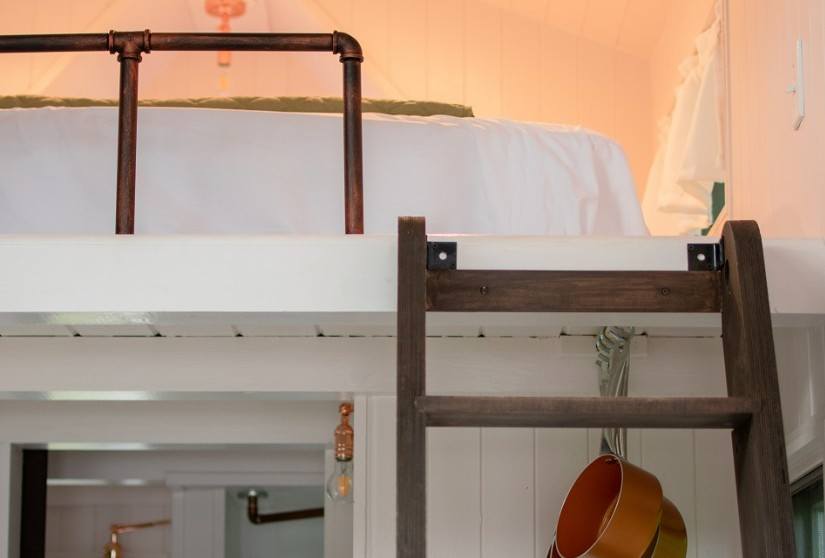How difficult do you think it is to pick out chiIdren’s bunk beds? The first choice is for your children and then there are others who may be using them. If you’re like many families, there’s bound to be others using them.
Over-night stays by friends and family often call for extra sleeping arrangements. Bunk beds can be your perfect answer.
This is especially true if your children have invited a classmate over for one of those “pajama parties”! Late night TV and popcorn, eventually conking out on a super comfortable bed. Children’s bunk beds can come to your rescue!
When you think of a bunk bed, we all know it’s basically one twin bed on top of a second twin bed. At least that’s the way they started out years ago. Now there’s an array of styles, many of which are mentioned below.
These are normally used by children in their bedrooms. If you have a couple of younger kids, children’s bunk beds are a great way to share limited space. Plus, it helps with the budget. Being of the same sex is very important of course, due to privacy. If this is impossible (in the very early years), some parents have been known to put up a privacy curtain for the bunk located at the bottom.
I do not recommend bunk beds for children ages five and under. That’s the age where they tend to fall out and, in some cases, they are hurt.
We will cover in this article: the different types of bunk beds, metal compared to wood, what to think about when buying and Consumer Safety Inspection for children’s bunk beds.
The Different Selections/Types of Bunk Beds
There certainly are a lot of options to think about. You will be considering what they look like. Will they last a long time? How well-made are they?
Styles include Futon, Loft, L-shaped, Novelty, Standard, and Study bunk beds. These are the more popular, but there are certainly many other combinations that are sure to tickle your fancy. They come with ladders to get to the top bed. Most include rails so a child does not fall out.
- Futon Bunk Bed. This type of bunk bed has two levels, upper and lower. The lower really serves as a sofa or a bed.
- L-shaped Bunk Bed. If there is plenty of space in your room, you can organize the L-shaped bunk bed so it angles to the right of the bed above.
- Loft Bunk Bed. Actually there is just one bed on top with space undern
 eath. Instead of a bed being on the bottom, you have room for a dresser or chest if you’re short on space, or a simple area where the child can play. For small spaces, this is a great way to go.
eath. Instead of a bed being on the bottom, you have room for a dresser or chest if you’re short on space, or a simple area where the child can play. For small spaces, this is a great way to go. - Novelty Bunk Bed. Just think of these as some kind of exciting “novelty ideas” your kids enjoy. Do they love different cartoon characters? How about silly cars or special baby dolls. Then there are ideas from movies. I think you get the picture. Have fun and be creative!
- Standard Bunk Bed. Simply stated, it is two beds, one over the other, usually in twin size. The advantage is that two take up the space of one. In addition, the two beds can normally be taken apart to be used as single beds later.
- Twin Over Full Bunk Bed. As is defined, it is simply a twin bed on top of a full size bed on the bottom. With children of different sizes and growing spurts, this may be a great idea.
- Study Bunk Bed. Just as it sounds. You have a bunk above and a wonderful study area underneath with a desk (which can be designed to fit into the bed), a chair, files, or even bookcases.
Metal Compared to Wood Bunk Beds
- Metal Bunk Beds. These are quite sturdy. However, they are not as strong as top quality hardwood. Metal is able to carry weights from one hundred and ninety to two hundred and twenty-five pounds on the top bunk. There is a huge collection available and these are some of the least expensive. As far as the modern look of metal, it has become extremely popular.
- Wood Bunk Beds. In my thirty-five years of experience, I believe hardwood to be the best choice for durability and long-term use. This would include oak, ash, cherry and poplar as great choices. Try to avoid beds made of particle board and other pressed woods. Of course, there are also soft woods to consider, and example would be pine. They are sturdy but not as strong as hardwood. This is the reason that hardwood investment costs a little more but is well worth it.
- Plastic Bunk Beds? THEY JUST DON’T WEIGH MUCH! Avoid unless the children are very small. Yes, they are reasonably inexpensive. However, I don’t recommend plastic bunk beds under any circumstances!
What To Think About When Buying
Some thoughts that come to parents’ minds are: What’s the price? Should I measure the room? How much can a child weigh?
1. Many folks are on a budget of some kind. So, manufacturers accommodate varied incomes and needs. There are a wide range of price points.
If you are choosing a new bunk bed, you could be looking at pricing from the low hundreds to eight hundred and fifty or so. Then again, it’s possible to spend into the thousands, depending on quality materials and even custom-made children’s bunk beds.
2. I’m sure you’ve considered measuring the bedroom. What’s the height, width and length of the space where you’re putting the bed? Is it a flat, angled or other unusual shape of a ceiling?
3. Be sure to double check manufacturer’s suggested weight limits for the type of children’s bunk beds you are considering. Weight maximums can vary depending on the quality and materials of the bed.
Standard Consumer Safety Specification For Bunk Beds

We all love our children and I would be amiss if I didn’t share this with you. This Consumer Product Safety Commission information is required of manufacturers in regard to the potential hazards associated with falls from the top bunk or being trapped.
The structure of the product is a consideration, which includes the support system of the foundation.
There must be a label of warning and identification of the manufacturer. Consumers are to be instructed on how to use the bed.
There are also mandatory rules by the Consumer Product Safety
Commission (CPSC). Among the rules that limit accidents are those that keep children from being trapped between the top bunk and the wall.
For in-depth details check: United States Consumer Product Safety Commission–Bunk Beds
To Bunk Or Not?
Well, there you go, parent(s). I hope you’re looking forward to the terrific choices you’re about to make about children’s bunk beds. You have a huge selection available. We raised our children on bunk beds and I grew up on them as well. I think they are a terrific choice. I can recommend them in full confidence.
We’ve honed in on four major areas I consider to be very important. The different types and purposes of children’s bunk beds, metal compared to wood, buying (prices), and safety standards. If you have any constructive feedback or questions, please reply in my comment section below.
Carson Dane, Founder
Furnitureplusdecor.com

